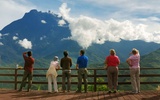Kota Kinabalu Islands, otherwise known as Tunku Abdul Rahman Park, comprises five islands - Gaya, Manukan, Mamutik Sapi and Sulug - spread over a vast 4,929 hectares of ocean.The islands are located just 15-20 minutes boat ride offshore Kota Kinabalu city in the east Malaysian state of Sabah. In 1974, the park was gazetted as Sabah’s second national park and was named after Malaysia’s first Prime Minister. It was created as an initiative to help protect the natural flora, fauna and marine ecosystems of these islands and has now flourished into a thriving eco-tourist destination.
Island hopping in Kota Kinabalu is the epitome of Sabahan tropical living.The islands, with pristine white sandy beaches and crystal-clear waters, are ideal for swimming, snorkelling, various water sport activities and basking in the sun. As a well-preserved marine park, the coral reefs are in excellent condition and filled with a plethora of marine life. Each island has a number of popular dive sites with regular sightings of sea turtles, nudibranchs, sting rays and reef sharks.
The islands are easily accessible via Jesselton Point Ferry Terminal where a number of boat operators and dive centres can be found. Along with your ferry ticket, here you can also arrange various water sport or scuba diving activities on the islands.


